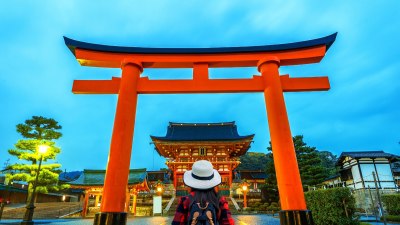Why Cinematic Travel Is More About Emotion Than Destination
Explore how cinematic travel captures emotions and experiences beyond mere destinations.

Image by senivpetro on Freepik
When we think about travel, we often picture picturesque landscapes, exotic cuisines, and famous landmarks. However, there is an emerging trend that places greater emphasis on the emotional journey rather than simply the destinations. This phenomenon, often termed 'cinematic travel,' encapsulates the idea that the essence of travel lies in the emotions it evokes, much like a captivating movie. In this article, we will delve into why cinematic travel transcends geographical boundaries and taps into human experience, making it a profound form of exploration.
The Power of Storytelling
Storytelling has been a fundamental aspect of human culture since time immemorial. The way we narrate our experiences shapes how we understand the world around us. In cinematic travel, the narrative often plays a crucial role in conveying the emotional richness of a journey. Instead of only documenting our routes and experiences, visual and auditory storytelling, akin to film techniques, provide a multilayered approach to travel narratives. When we recount our travels, we can emphasize the connections we made, the challenges we faced, and the beauty we witnessed, crafting a compelling story every bit as engaging as a well-directed movie.
Emotional Landscapes
Every destination is imbued with its unique emotions. When filmmakers design travel documentaries or feature films, they often highlight specific landscapes that resonate with the film's mood. The chill of a winter landscape can provoke feelings of isolation, while the warmth of a sunset on a beach may evoke a sense of calm and peace. Cinematic travel inspires us to seek these 'emotional landscapes'—places that evoke specific feelings, enabling us to connect with our inner selves on a deeper level. When we travel to fulfill our emotional yearnings, rather than ticking boxes on a to-visit list, we embark on a more profound journey.
Cinematic Techniques and Their Effects
Many filmmakers use particular cinematographic techniques to elicit emotional responses from their audience. These techniques can also be applied to our travel experiences. For instance, close-ups can create an intimate atmosphere, while sweeping panoramic shots can inspire awe and wonder. As travelers, we can replicate these techniques by capturing emotionally charged moments, such as a child's laughter, a couple’s tender embrace, or the vibrant colors of a bustling marketplace. By focusing on the emotions these moments evoke, we transform our travels into rich, cinematic experiences.
The Role of Music and Sound
Music and sound design play a vital role in affecting our emotions in films. Much like a moving soundtrack can amplify our feelings as we watch a movie, the sounds we encounter on our travels can significantly impact our emotional state. The rustle of leaves in a serene forest, the distant chatter of a crowded street, or the rhythmic crashing of ocean waves can evoke powerful feelings and transform an ordinary moment into an extraordinary memory. Being aware of the soundscapes as we explore enables us to deepen our emotional connection to our experiences.
Connection Over Geography
This shift towards emotional travel also emphasizes the importance of human connections over geographical distances. Cinematic travel often highlights relationships and interactions as paramount to the travel experience. Meeting local people, learning about their stories, and sharing in unique cultural practices can foster deeper emotional experiences than simply visiting a checkpoint on a map. When we prioritize connections with others, we create bonds that enrich our journeys. These interpersonal exchanges remind us that while we may travel the world, we are united in our shared humanity.
The Influence of Social Media and Modern Technology
In today’s digital age, social media platforms play a significant role in shaping our travel narratives. Through images, videos, and stories, travelers can curate emotional experiences and share them with a global audience. This visibility can inspire others to embark on their own cinematic journeys, focusing more on the emotions connected to their travels rather than just the scenic views. Furthermore, modern technology allows us to capture and share these emotional experiences in ways that were previously unavailable, facilitating a deeper connection to our travels.
The Impact of Culture and Art
Cultural expressions, such as art, music, and dance, often deeply resonate with emotions tied to specific places. Many travelers set out to explore how various cultures express their stories through different mediums. Artistic experiences can evoke powerful emotions, providing travelers with insights into the heart and soul of a place. Engaging with local art forms can lead to a deep emotional connection with a destination, as it allows us to experience the cultural heartbeat of the place we are visiting.
Returning Home Changed
The culmination of cinematic travel is often a profound realization that returning home can alter one’s perception of the world. The experiences we gather shape our thoughts and feelings, leading to growth and introspection. Just like a well-crafted film that lingers in your thoughts long after the credits roll, the emotional impact of travel can inspire lasting change in our outlook and self-discovery. The transformative power of cinematic travel underscores the idea that we are all storytellers, translating our explorations into narratives that resonate with our experiences and emotions.
The Future of Travel
As we move towards a future where emotional intelligence is becoming increasingly valued, the concept of cinematic travel finds its footing in our travel practices. More than just visiting a destination, we seek meaningful experiences that enhance emotional well-being and foster a sense of connection within ourselves and with others. As the travel landscape evolves, the emphasis on curated emotional experiences will likely shape not just how we travel, but also how we recount our adventures, fundamentally changing the narrative of exploration altogether. The emotional essence of travel, much like the art of cinema, will continue to inspire and enrich our lives, beckoning us to explore not just new destinations but the depths of human experience itself.











